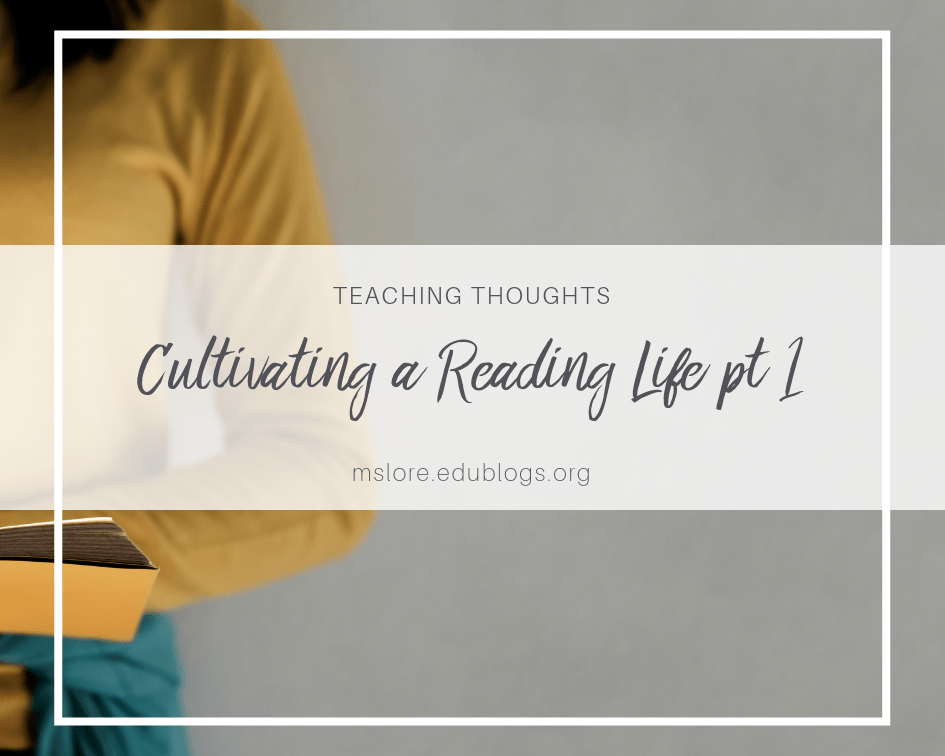
What does it mean to be a reader?
I asked this question of my seniors earlier in the week before I had them fill out a reader’s interest survey. Their answers, in all three classes, were quite similar. They said things like:
- someone who reads a lot
- someone who enjoys reading
- someone who reads in their free time
- someone who reads to escape reality
- someone who likes books
- someone who will read anything. anytime.
- someone who reads without being forced too
And my favorite:
- someone who doesn’t have a life.
To which of course I responded how I read 5 books (4 were a graphic novel series) over the weekend and probably did more in the three days than he did all week. I got a collective burn from that one, and silently patted myself on the back. But I digress.
My point here is most of my students are stuck in a box. To them, readers are people who love to read. Readers are not themselves.
To expand the discussion, I added in things such as readers are people who “discuss books,” “visit libraries,” visit bookstores,” “recommend books,” “empathize” “try new books until they find a genre they like,” and as we kept talking, my students started adding more things to the list. Readers “imagine” and “visualize.” They “like the book better than the movie” “are open-minded,” and “have their own library at home.” I finished discussion with the challenge that I was going to change their reading views the year, promptly making them readers.
Some scoffed. A few in my third hour said they’d already read more books the first two weeks than they’ve read their entire school life (might I remind you, they’re seniors) and I said, “See. Give reading a chance and books will surprise you.”
Last year was the first year I’ve ever taught seniors, and as I enter into my sixth year over all, I’m realizing how important it is to deconstruct my students’ views of reading and build them back up before they go off into the world. Especially when a senior nonchalantly proclaims to you that he’s never read a book in school. I must admit, I find that hard to believe as I would hope he’s read at least one book at some point in the last 12ish years, but the sad reality is that he very much could be speaking the truth.
We live in a digital age and the kids I teach everyday, from here on out, continue to use technology more and more, which I see as an obstacle pushing reading aside.
So how do we fix that? What can we, as teachers, do?
Make reading a priority.
Can I get emoji clap hands here because I don’t mean just “here, read this book by this time.” I mean we should let students choose their books. Embrace their tastes. Discuss books. Get angry about books. Abandon books.
But mostly, we have to make reading something kids will enjoy and come back to again and again when they leave the classroom.
Here are just a few ways I think we can do that.
How do we cultivate readers?
5 suggestions from a self-proclaimed bibliophile-turned-teacher
- Read yourself. This might seem obvious, but I’ve known English teachers (and pre-service teachers) who do. not. read. How one can teach books without ever reading them is beyond me, but I know people who do it. The truth is, if we’re to encourage our students to read, we have to read ourselves. We should read what we love. We should read what’s popular. We should read at the grade level of our students (young adult or middle grade). We should reread books we love. We should read recommendations. We should read graphic novels. We should read from lists. And we should also abandon books we don’t love to show our students it’s okay not to finish a book.
- Share what you’re reading. After we’re finished reading, we need to share what we’ve read. Especially if you love it. One of my favorite ways is to create a space in my room where I post covers of what I’m currently reading/just finished so my students can keep up. Often they’ll ask me what I think about the book I’m reading or what I finished over the weekend. I host a 40 book challenge every year and keep a dedicated space on my walls to keep track of my yearly book count. Other ways to share what you’re reading is to use images of your reads as a screen savor or pull up a cover on your SMART board for the opening of class. Maybe display the book itself on your desk when you aren’t reading it. Book talks are fabulous, too. Dedicate a day to share books you’ve read and love OR books that are all the rage right now. Invite the librarian down to your classroom as well to give book talks on popular reads. And never underestimate the power of social media.
- Fill your room with books. I know. Teacher budget. But there are ways to get books into your classroom. Think thrift stores or Thriftbooks.com. Amazon wish lists that you solicit Facebook friends for donations. BookOutlet.com (<– my link will get you $10 off!) Donor’s Choose projects. Garage sales. I’ve used them all over the years. And when you fill up your shelf or shelves, use book stands to display current and/or popular books. Change up book displays for different times of the year. Or if your classroom budget is zero, pull up booklists on the computer or print off covers to hangup All of these things help students see books which is what they need to start reading. This year, I’m displaying different genres every month in the front of my room, and I do not have near enough budget to buy them all, so I’ve created a bulletin board with ever revolving visuals of paper book covers. I’m hanging them up with a little dry erase message bubble for quick recommendations, but one could also QR code book covers to their Goodreads summary or book trailers!
- Give students choice. To both read AND share. I know that sometimes projects are easy, but if you’re a reader, do you really make a movie poster of your book and hang it on your living room wall? No. My teaching philosophy for my classroom is that I won’t make students do the things I don’t want to do in my own reader life. So in my classroom, we read books and talk about them. (And occasionally blog about them.) I set aside two Fridays a month (the 1st and 3rd) to gather and chat about the books we’re reading. We have mini book clubs and talk about why we chose the book, how we connect to the characters, and what we love/hate about the story. At the end of the month, we’ll wrap up our read by recommending it to others and talking about future picks.
- Make time for reading. Again, this one seems easy, but seriously, we have to give students time in the classroom to read. I’ve learned over my last several years that reading trumps a lot of things, so I start each class with 10 minutes of reading every. single. day. Reading is my bell ringer and sure, it cuts my teaching time down, a lot, but I also watch kids expand their perspectives and read more than they ever have before. They also expand their vocabulary and improve their comprehension. Some days, it’s not possible though and I get it, so if you can only fit in 10 minutes one day a week–that’s a start. Go for it.
I get that not all of these ideas will work for your classroom or you may look at my list and think, there’s no way my administration/budget will allow for that. To be honest, I feel like I’m only brushing the surface of getting my students to read, and it’s taken me six years plus probably many more of failing. There are days when no one can stay awake during SSR, some students who refuse to pick anything other than the Diary of a Wimpy Kid series which they’ve read three times through, or a few students who simply won’t read. Ever. All year long. In fact, I’ve been in a major reading slump myself this summer, so my list of new recommendations is small and I’m struggling to find a good rhythm of reading myself.
The point of all this rambling is that different things work for different classrooms in different seasons–but I think the heart of the matter is that even the most non-reader of readers can still be a reader while they’re in our classrooms.
It just takes someone to believe in the power of story and share it with them.
And that someone, is you.
– Ms. Lore
If you liked today’s post, make sure to subscribe to my newsletter where I share reading recommendations, my own writing, & thoughts like these a few times a month.
I’ll also send you my 40 Book Challenge Guide as a thanks for subscribing!
